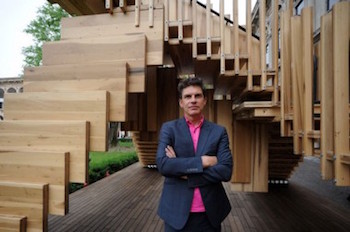21 Reasons Why Wood is Better than Other Materials: Prof. Alex de Rijke
Responsible for the often-quoted statement, “If the 19th century was the century of steel and the 20th century the century of concrete, then the 21st century is about engineered timber.” Prof. de Rilke has a record of pioneering the innovative use of engineered wood products.
In a presentation entitled ‘Experiments in Engineered Timber’ Alex shared his practice’s fascinating journey through a decade of working on high-profile engineered timber projects.

His 21 Reasons Timber is Better Than Steel and Concrete summarises his thoughts and is an eclectic mix of rational and emotional reasons and highlights both his pragmatic approach to the specification of materials and his deep love of timber and the environment.
- Growing trees to use for timber construction not only absorbs carbon dioxide, but all kinds of other particulate pollution. Also, trees produce oxygen while they are growing. If we plant three trees for every one that is harvested, and live with trees as well as build with them, we have a healthier environment.
- The speed of engineered timber construction is faster than working in concrete or steel, and there is a reduced need for following trades such as plaster board installers because a product like CLT is also the interior finish.
- Engineered timber construction is more precise, due to the numerical control and accuracy that can be achieved in the prefabrication factories.
- A higher standard of quality control is achievable in the factory setting, and there is no risk of weather damage.
- Mass timbers are lighter – around one-fifth the weight of concrete, which means less foundations are required – this further reduces the need for concrete and shrinks costs.
- There is less need for on-site storage, and transport is simplified as building components are transported as flat packs on a just-in-time basis.
- CLT is a continuous structure.
- With CLT the structure is integrally braced and integrally strong – it is solid, not based on a frame and not reliant on joints or bracing.
- Timber is dry, clean and non-toxic to work with, making for a safer and cleaner site operation.
- Construction is a simple matter of assembly, specialist personnel are not required.
- It’s DIY friendly – building occupants can fix anything to anywhere on the walls, instead of searching for the timber stud behind plasterboard or drilling into concrete to hang a picture or mount a shelf.
- Services can be easily integrated, with penetrations pre-cut in the factory.
- It’s flexible – occupants or owners can change their minds about the building interior at any time, for example cutting additional doors or windows.
- The structure is the finish, interiors do not need plasterboard or paint, which reduces time, costs and materials.
- It’s durable, strong and repairable – concrete by contrast is extremely hard to repair.
- It’s warm – timber has its own thermal properties, so needs less insulation to get a very warm or cool building. This means it’s easy to go beyond code minimum. De Rijke’s practice has also used insulation that is manufactured from the sawdust waste created from mass timber manufacture.
- Timber is interesting – it has a tactile and sophisticated surface people are drawn to and interested in – unlike concrete.
- Timber is safe and healthy to inhabit and build with, and is non-toxic for trades such as lighting installers to drill into, giving off only sawdust and the smell of wood.
- Timber has intrinsic colour, and can be easily stained for different effects or enjoyed in its natural shades.
- It has a high level of compatibility with other materials due to easy connections, for example connecting steel brackets or constructing hybrid structures.
- “It’s just way more sexy than steel or concrete,” Prof.
Professor Alex de Rijke visited Australia in November 2015 to present a series of seminars in conjunction with Planet Ark and WoodSolutions. Attended by leading design, engineering construction and property developers, the seminars provided an informative and inspiring look at the immediate and longer term future of wood and wood products.
de Rijke said. “People like wood.”
Alex de Rijke studied and worked in London and Amsterdam before establishing dRMM (de Rijke Marsh Morgan Architects) with Philip Marsh and Sadie Morgan in 1995. Alex has had various roles in academia, most recently as Professor of Architecture at the Royal College of Art.
dRMM’s work is characterized by social relevance, conceptual clarity and inventive use of materials. Built projects have been the subject of much critical acclaim, and the practice has received many design awards. Alex combines dRMM leadership with ongoing research into contemporary materials, methods of construction and new sustainable technologies.
Alex’s interests include: laminated timber structures, architecture in relation to digital working methods, prefabricated and mobile architecture. He has taught and lectured around the world.
dRMM - www.drmm.co.uk
